Hi there! Did you think I’d given up gardening (and blogging)? Like our gardens, I’ve been dormant. February is usually lousy for gardening in Kansas City, and this year started out no different, with temperatures near zero and four inches of snow. For the past month all I’ve done is look at garden pictures and daydream. Today I roused myself from the couch where I was rewatching episodes of BBC’s Gardener’s World and looked outside. What did I see? This is February? Brilliant sunshine, blue sky, sixty degrees?
Is February the new March?
Two images jumped out at me recently. The first was a post in the Kansas City Gardeners Facebook group by a guy who tossed poppy seeds on top of the snow last year. The picture of the beautiful bed of blooming poppies that resulted made my heart beat faster. I could do that! I could be the Johnny Appleseed of perennial wildflowers. It’s novel to think of, but flowers produce seeds to make new plants—at no cost to anyone. Not only that, last fall I walked around snapping twigs and filling my pockets with crunched-up stems. I’ve saved plenty of seeds, stored in envelopes neatly labeled as “Pretty grass” and “Dark pink thing from neighbor’s yard.”
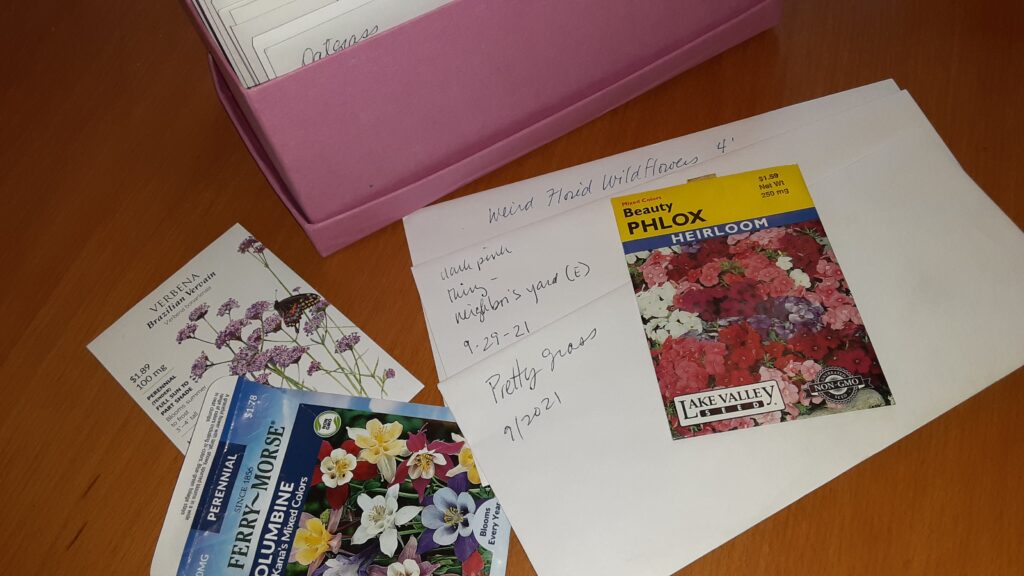
Sowing wildflowers can be complicated, it turns out. I can’t just scatter seeds on the snow and expect future flowers (although I can try). Native plants have evolved many mechanisms to prevent them from dying in our crazy back-and-forth spring weather. Some require soaking; others need to be nicked to remove protective coatings (scarification). It looks like most wildflowers need to experience cycles of freeze and thaw, so it’s best to plant seeds in the fall. Many take more than a year to germinate: propagation is a long game, apparently.
Matching method to seed is not easy. I’m looking here (Prairie Moon Nursery’s blog post “how to germinate native seeds”)and here (American Meadows’ “How to cold stratify seeds”) for step-by-step instructions. I spent a couple hours on Sunday breaking open pods and liberating seeds. Some are so tiny, mere specs, smaller than pepper. It’s amazing that any ever sprout. I’ve also developed new respect for birds. They have to work so hard for such little bits of nourishment. I now understand why they are so small.
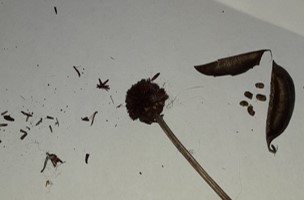
Much of the information I’ve found about seed starting pertains to vegetables. (Here’s a link to Margaret Roach’s calendar: When to Start Seed. Our last frost date is April 14. And here is KCCG’s planting calendar.) I am trying a couple things, but the stakes are low. If nothing sprouts, all I’m out is a couple plastic milk jugs and some seeds which easily could be mistaken for dirt. I’ll keep you posted.
The second image to make me sit bolt upright was of this garden, designed by Spanish gardener Fernando Martos.

I know, I’ve never heard of him either, and I don’t have permission to use his photo—but what a website! His gardens are gorgeous. I love seeing how he’s adjusting a new perennial style to fit Mediterranean circumstances.
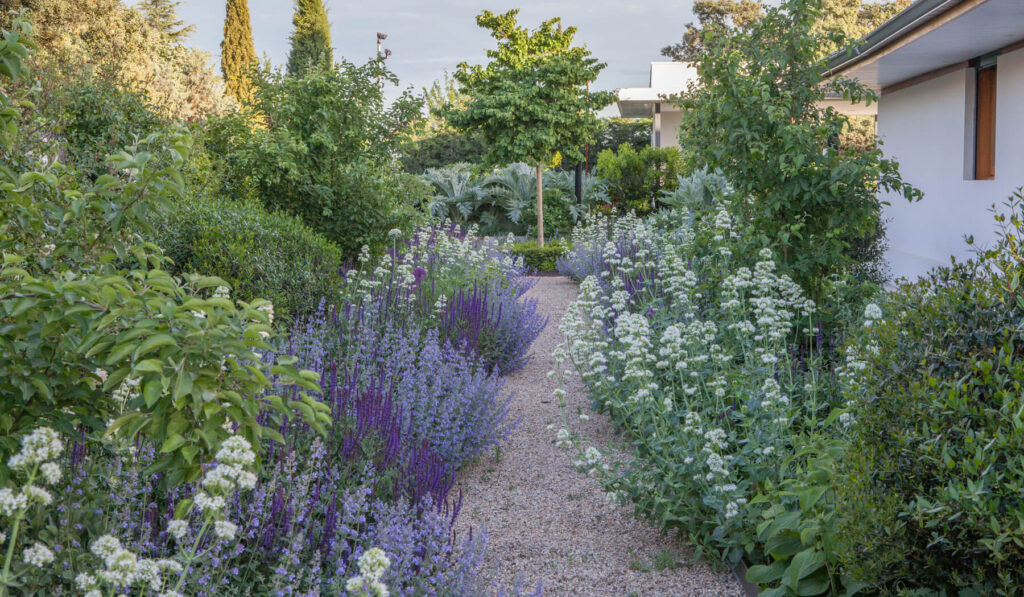
This photo is so beautiful it made me hyperventilate. I like having a big idea, some context, a plan. I’m not a pick one plant here and another there, put them in the ground and hope for the best type—although you couldn’t tell from the way my garden looks. I also like purple flowers. I want this, or something approximating it (minus the boxwood surrounding the tree). I have gravel. I have salvia and nepeta. But what is that white flower?

I Interrupted my professional gardener friend’s beach vacation in Mexico to ask her to identify it.
“Hard to tell,” she texted back, “other than the fact that it is a weedy nasty invasive…”
“Centranthus ruber ‘albus’” she decided later. “Not as weedy as I thought but a bit large for your garden.”
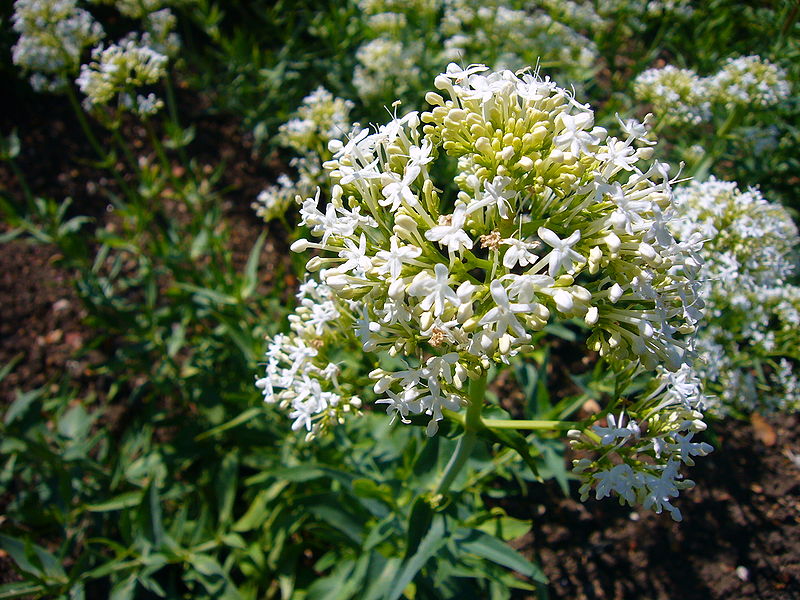
If that is indeed what it is, sadly, she is correct about the size. According the Missouri Botanical Garden,
Centranthus ruber, commonly called red valerian or Jupiter’s beard, is a well-branched, bushy, clump-forming, woody-based perennial which is valued for its ability to produce, often in poor soils, a showy bloom of star-shaped crimson, pink or white flowers from spring to frost.
This sounds wonderful—poor soils, showy blooms—but the height—1.5 to 3.00 feet—is a deal breaker. Nothing taller than 24” is my new mantra. No exceptions. In my yard, plants whose maximum height is three feet generally grow to five. If I’d listened to my friend’s advice in the first place I wouldn’t be in this mess (natives 5-6’high scaled too big for our small suburban lot, lots of money wasted, dashed hopes, etc.).
Since the gardener in me is awakening, I’m going to finish writing and head to the library to check out Small Garden: Contemporary Principles, Planting and Practice, by Noel Kingsbury.
But before I go, I’ll answer my own question. Don’t be fooled by the warm temperatures. No, February is not the new March. Our last frost date is still April 14. I’ll head outdoors and start some projects—trim some hedges, install an edge, slap some paint on our Adirondack chairs. But my big project this spring will be moving things around, and it’s too early to start yet..
In case you’re curious, here are the dark pink things from the neighbor’s yard. When I picked them, the seeds exploded in my hand, like popcorn.
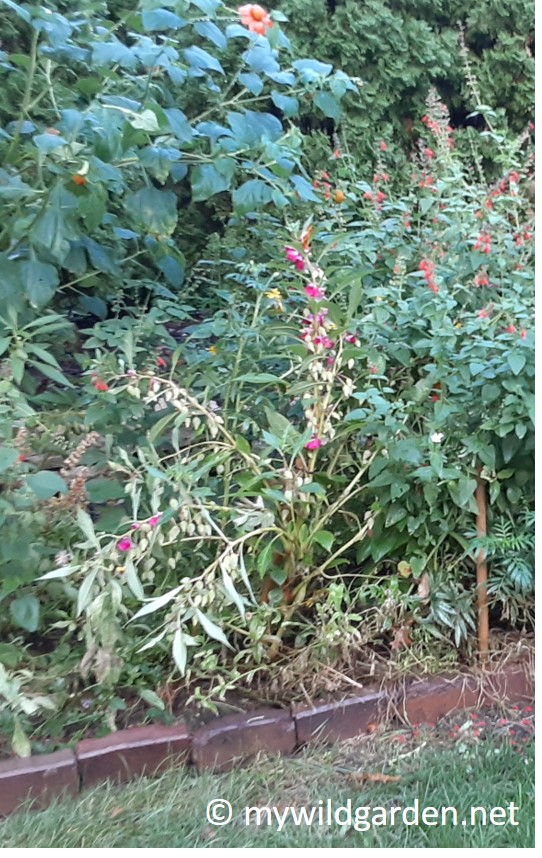
Thanks for reading!
Resources
Prairie Moon Nursery / How to germinate native seeds / Prairie Moon Nursery’s blog post “how to germinate native seeds”
American Meadows / How to cold stratify seeds / https://www.americanmeadows.com/blog/2018/03/07/how-to-cold-stratify-seeds
Margaret Roach / When to Start Seed / When to Start Seed
Kansas City Community Gardens / Planting Calendar / KCCG’s planting calendar
Fernando Martos / Garden III, Moraleja, Madrid / http://fernandomartos.com/en/proyectos/jardin-en-la-moraleja / /
Missouri Botanical Garden / Centranthus ruber / https://www.missouribotanicalgarden.org/PlantFinder/PlantFinderDetails.aspx?kempercode=b950
